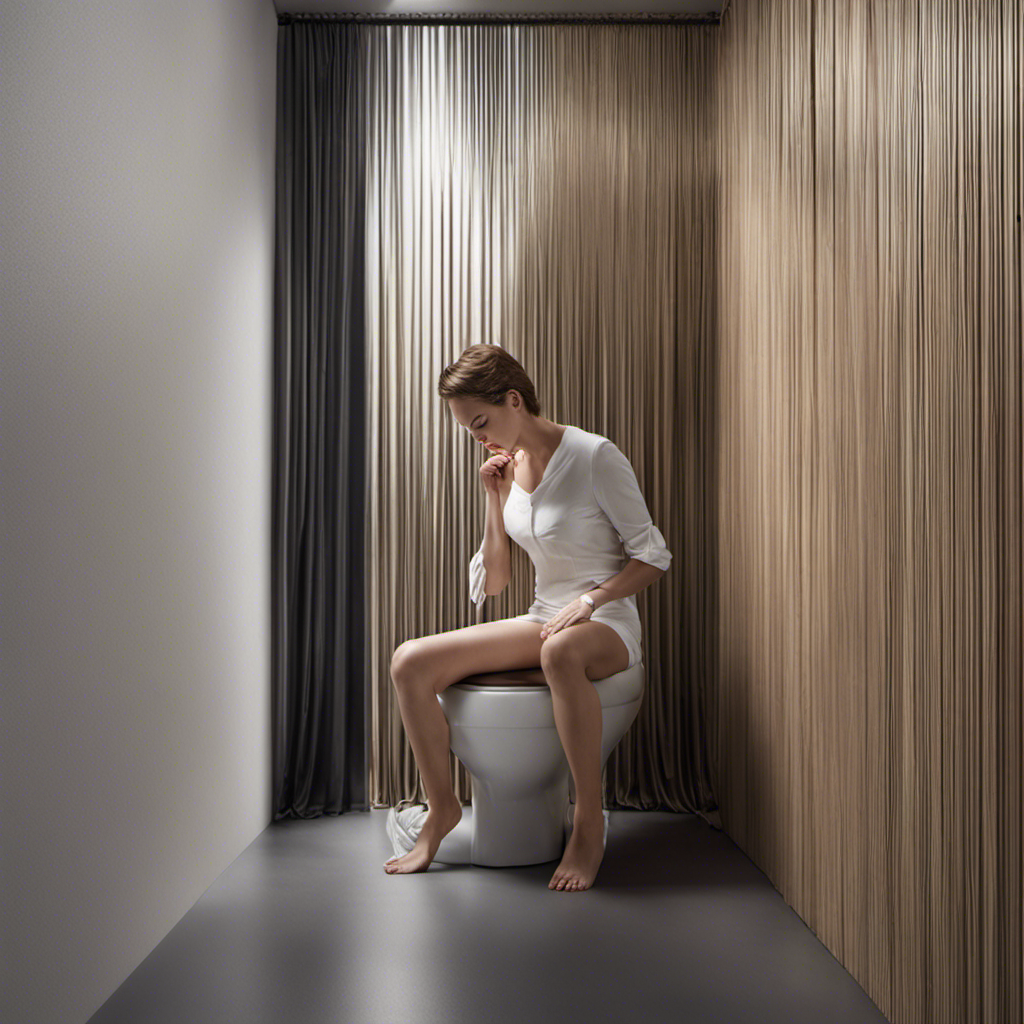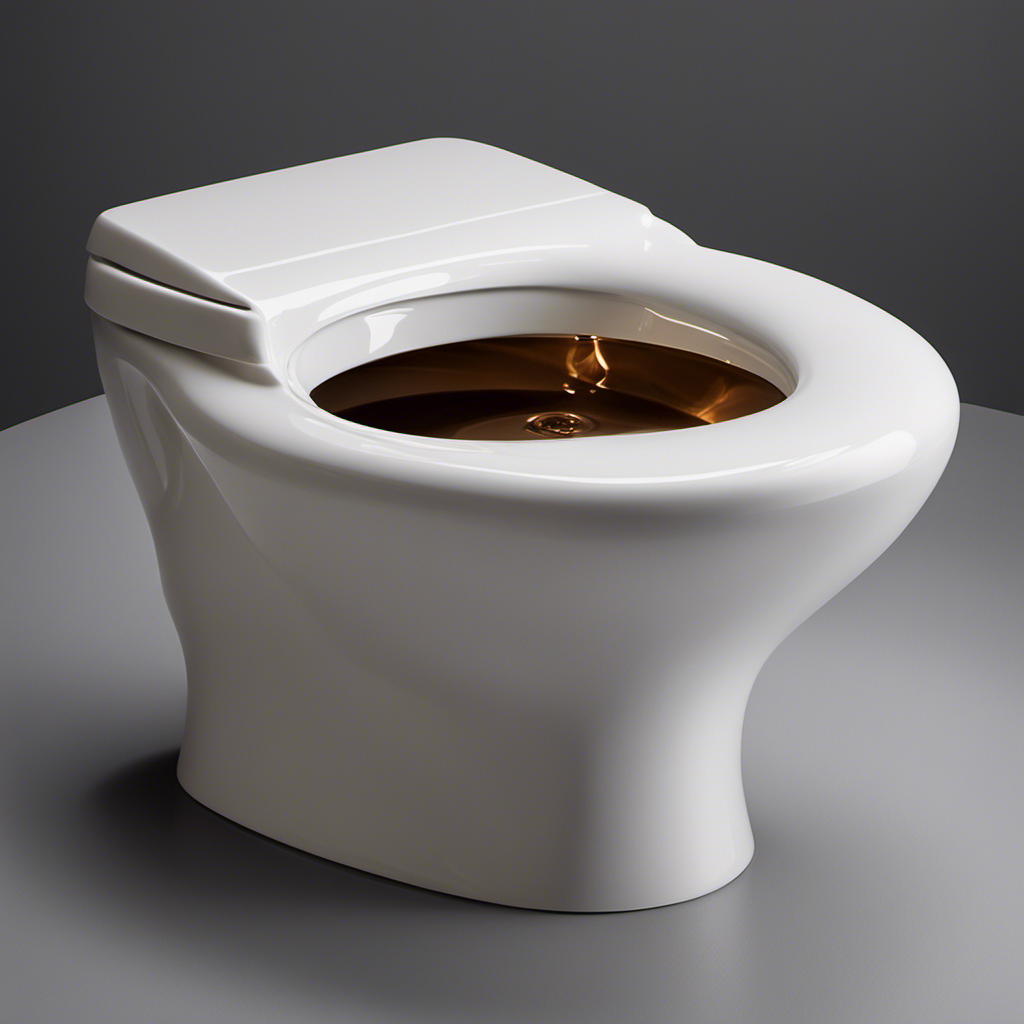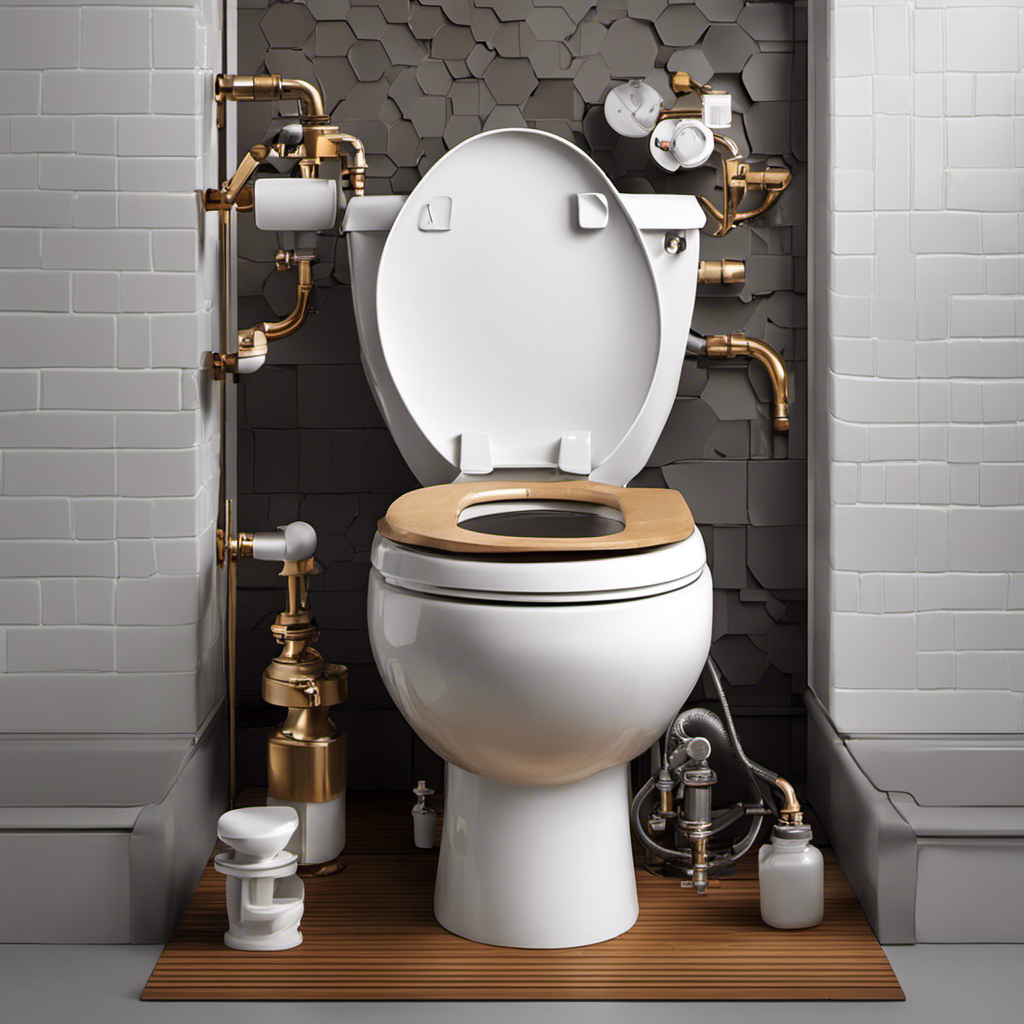As I sit on the toilet, I can’t help but notice the strange sensation in my feet. Why do they always seem to fall asleep in this position?
In this article, we will explore the science behind this phenomenon and uncover the reasons behind numbness in our feet while using the toilet. By understanding the role of pressure, body positioning, and blood flow, we can gain insight into how to prevent this uncomfortable sensation.
So, let’s dive in and uncover the mysteries of why our feet fall asleep on the toilet.
Key Takeaways
- Numbness in the feet on the toilet can occur due to restricted blood flow and compressed or pinched nerves.
- Prolonged sitting on the toilet can lead to reduced circulation, compression of nerves, impaired muscle activity, restricted blood flow, and inactive nerve function, resulting in foot numbness.
- Excessive pressure on nerve endings, such as from sitting on the toilet for an extended period, can cause tingling or numbness in the feet.
- Poor body positioning, such as slouching or crossing legs while sitting on the toilet, can impede blood flow and contribute to foot numbness.
Understanding the Sensation of Numbness
When my feet fall asleep, it’s because the blood flow is restricted, causing a sensation of numbness. This tingling sensation occurs when the nerves in my feet are compressed or pinched due to prolonged pressure or awkward positioning.
Sitting on the toilet for an extended period can lead to this sensation, as the blood vessels in my legs can become compressed, limiting the supply of oxygen and nutrients to my feet. Additionally, sitting in a fixed position for too long can cause muscles to tense up, further restricting blood flow.
It’s important to change positions regularly and avoid prolonged pressure on the feet to prevent this tingling sensation. Stretching and massaging the feet can also help alleviate the numbness and restore proper blood flow.
The Role of Pressure on Nerve Endings
Pressure on nerve endings can cause sensations like tingling or numbness. This is due to the fact that nerve endings are highly sensitive to pressure. When excessive pressure is applied to these nerve endings, it can interfere with their normal function and lead to abnormal sensations.
This phenomenon is known as pressure sensitivity. Nerve conduction, which is the transmission of signals along the nerves, can be affected by pressure as well. When pressure is exerted on the nerve, it can disrupt the conduction of signals, leading to altered sensations in the affected area.
Understanding the role of pressure on nerve endings and its impact on nerve conduction can help explain why certain activities, like sitting on the toilet for an extended period, can cause our feet to fall asleep.
How Body Positioning Affects Circulation
If you sit in one position for too long, it can affect the circulation in your body. Poor body posture can lead to circulation problems, causing discomfort and potential health issues.
Here are three ways how body positioning can impact circulation:
-
Slouching: When you slouch, your spine is not properly aligned, which can compress blood vessels and impede blood flow to your extremities.
-
Crossing legs: Sitting with crossed legs can restrict blood flow, especially to the lower limbs, leading to numbness and tingling sensations.
-
Sitting for extended periods: Prolonged sitting reduces muscle contractions that assist in pumping blood back to the heart. This can result in blood pooling in the legs and feet, causing swelling and discomfort.
Understanding the effects of body posture on circulation is crucial in preventing circulation problems.
Now let’s explore the link between sitting and foot numbness.
Exploring the Link Between Sitting and Foot Numbness
As I’ve experienced it myself, sitting for long periods of time can often lead to that uncomfortable tingling sensation in the feet known as numbness. This connection between sitting and foot numbness is due to the pressure and decreased blood flow that occurs when we remain in one position for extended periods.
The causes of foot numbness can vary, ranging from nerve compression to poor circulation, and understanding these factors can help us find ways to prevent and alleviate this discomfort.
Sitting and Numbness Connection
When you sit for long periods, like on the toilet, your feet can fall asleep due to decreased blood flow. It’s a common discomfort that many people experience and can be attributed to the design of the toilet seat.
Here are three factors that contribute to this issue:
-
Pressure points: The design of some toilet seats can create pressure points on the back of your legs and thighs, restricting blood flow to your feet.
-
Lack of support: Sitting on a toilet seat for an extended period can cause discomfort and strain on your legs, leading to numbness and tingling sensations in your feet.
-
Improper posture: Sitting in a slouched position or with your legs crossed can further exacerbate the problem by compressing nerves and blood vessels, reducing circulation to your feet.
To alleviate this discomfort, consider using a cushioned toilet seat or adopting a more ergonomic sitting position.
Causes of Foot Numbness
Pressure points, lack of support, and improper posture are common causes of foot numbness. When we put excessive pressure on certain areas of our feet, such as the balls or heels, it can compress the nerves and restrict blood flow, leading to numbness. Additionally, wearing shoes that don’t provide adequate support can cause the foot to flatten and create pressure points. Poor posture can also contribute to foot numbness, as it can misalign the spine and put added pressure on the feet. To prevent foot numbness, it’s important to wear properly fitted shoes with good arch support, practice good posture, and avoid prolonged periods of standing or sitting. Regular stretching and foot exercises can also help improve circulation and alleviate numbness.
Here’s a table summarizing the causes and prevention of foot numbness:
| Causes | Prevention |
|---|---|
| Excessive pressure on certain areas | Wear properly fitted shoes with good arch support |
| Lack of support in shoes | Practice good posture |
| Improper posture | Avoid prolonged periods of standing or sitting |
| Regular stretching and foot exercises |
The Impact of Prolonged Sitting on Blood Flow
Sitting for long periods can restrict blood flow and cause your feet to fall asleep. This happens because when we sit for a prolonged time, blood circulation to our extremities, like our feet, can be compromised.
Here are three ways prolonged sitting can affect blood flow and contribute to feet falling asleep:
-
Reduced circulation: Sitting for extended periods can lead to decreased blood flow to the lower body, including the feet. This can cause numbness and tingling sensations.
-
Compression of nerves: Maintaining a seated posture for too long can compress nerves in the legs, leading to temporary loss of sensation in the feet.
-
Impaired muscle activity: Sitting for hours on end can cause the muscles in the lower body to become inactive, further impeding blood circulation and resulting in the sensation of feet falling asleep.
To prevent this, it’s important to take breaks, stretch, and maintain proper sitting posture to promote healthy blood circulation.
Nerve Compression and Its Connection to Foot Numbness
If you sit for long periods without moving, the compression of nerves in your legs can lead to temporary loss of sensation in your feet. This occurrence, known as nerve compression, happens when prolonged pressure is applied to the nerves, causing them to become compressed or pinched. When this happens, the nerves are unable to function properly, resulting in foot numbness. To better understand this process, let’s take a look at the following table:
| Nerve Compression | Foot Numbness |
|---|---|
| Prolonged sitting | Temporary loss of sensation |
| Pressure on nerves | Inability to feel your feet |
| Pinched nerves | Lack of sensation in the feet |
| Reduced blood flow | Numbness and tingling |
| Restricted nerve function | Impaired ability to walk |
As you can see, nerve compression can directly lead to foot numbness, making it essential to avoid prolonged sitting and take breaks to prevent this uncomfortable sensation.
Tips for Preventing Foot Numbness While Using the Toilet
To avoid experiencing foot numbness while using the toilet, it’s important to shift positions frequently and take breaks. Here are three tips that can help prevent foot numbness and discomfort during toilet use:
-
Maintain good toilet posture: Sitting with your feet flat on the ground and your knees at a 90-degree angle can alleviate pressure on the nerves and blood vessels in your legs and feet.
-
Engage in foot exercises: Flexing and stretching your feet and toes while sitting on the toilet can help improve blood circulation and prevent numbness. You can also try rotating your ankles or doing some simple foot massages.
-
Take regular breaks: Sitting on the toilet for prolonged periods can increase the risk of foot numbness. It’s beneficial to take breaks and walk around for a few minutes to stimulate blood flow and prevent nerve compression.
Conclusion
In conclusion, understanding why our feet fall asleep on the toilet is important for maintaining good foot health. The sensation of numbness is caused by pressure on nerve endings, which can be exacerbated by poor body positioning and prolonged sitting.
By being aware of these factors, we can take steps to prevent foot numbness. This includes adjusting our body position and taking breaks from sitting.
Remember, avoiding foot numbness while using the toilet is all about maintaining proper circulation and relieving pressure on our nerves.









